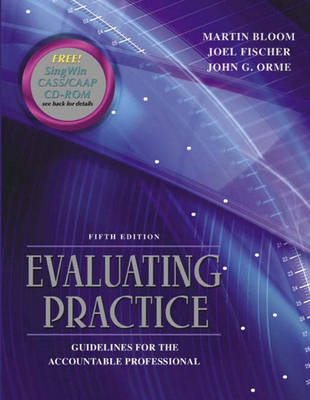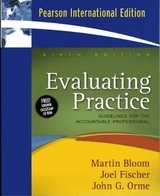
Evaluating Practice
Pearson (Verlag)
978-0-205-46698-6 (ISBN)
- Titel erscheint in neuer Auflage
- Artikel merken
Focusing on single-system designs, Evaluating Practice, Fifth Edition, presents clear guidelines on conceptualizing and measuring problems, developing practice-oriented evaluation designs, understanding and analyzing data, and ethical guidelines for practice evaluation. Specifically written for students and practitioners in all the human services, including social work, psychology, counseling, nursing and psychiatry. Unsurpassed among human service evaluation texts for bringing clarity to evaluation procedures, Evaluating Practice comes with a free CD-ROM featuring numerous programs, including the innovative SINGWIN program for analyzing data (created by Charles Auerbach, David Schnall, and Heidi Heft Laporte of Yeshiva University), and the CASS and CAAP programs (created by Walter Hudson) for managing cases and scoring scales.
The improved and expanded CD-ROM contains an “Intervention Plan” form that can be used to develop a comprehensive intervention and evaluation plan of action that parallels chapters in the text. The CD-ROM also contains a new “running case” that can be used interactively to try out concepts and procedures from the text. Significant updates to SINGWIN (on CD-Rom), including the incorporation of new statistical procedures designed for ease of application. And the prologue offers an extensive case illustrating the integration of practice, ethics, and evaluation for students, making the text even more appealing to practitioners.
I. WHAT ARE YOU GETTING INTO?
1. Integrating Evaluation and Practice.
Introduction to Single-System Designs.
What Are Single-System Designs?
Scientific Practice.
Single-System Designs and Classical Research: The Knowledge-Building Context.
Single-System Evaluation, Qualitative Research, and Quantitative Research.
Advantages of Using Single-System Designs in Practice.
A Walk Through the Evaluation Process.
II. CONCEPTUALIZING AND MEASURING TARGETS AND OBJECTIVES/GOALS.
2. Basic Principles of Conceptualization and Measurement.
What is Conceptualization?
What is Measurement?
Definition as First Step in Measurement.
Can Everything Be Measured?
Key Characteristics of All Measures.
3. Specifying Problems and Goals: Targets of Intervention.
Introduction: From General Problems to Specific Targets of Intervention.
Specifying Client Concerns: Identifying and Clarifying Problems and Potentials.
Specifying Goals and Objectives.
Using Goal Attainment Scaling (GAS) to Establish Goals.
Setting Goals in Groups.
Problems and Issues in Setting Goals.
4. Developing a Measurement and Recording Plan.
Steps in Developing a Recording Plan.
Charting: Putting Your Information on Graphs.
Problem-Oriented Records (POR).
Use of Computers in Evaluation and Practice.
Appendix: Installing CASS.
5. Behavioral Observation.
General Guidelines for Behavioral Observation.
Sampling Behaviors.
Instruments for Recording Behaviors.
Ensuring Accurate Observations.
Methods of Recording Behavior.
Analog Situations.
Recording Behavior in Groups.
6. Individualized Rating Scales.
Uses of Individualized Rating Scales.
Constructing and Using Individualized Rating Scales.
7. Standardized Scales.
What are Standardized Scales?
Selecting a Standardized Scale.
Administering a Standardized Scale.
Some Available Standardized Self-Report Scale.
Some Available Standardized Scales for Practitioners.
Some Available Standardized Scales for Relevant Others.
Some Available Standardized Scales for Independent Observers.
Do-It-Yourself Scales.
Using Standardized Scales in Groups.
Computer Management of Standardized Scales.
Appendix: Computer Assisted Assessment Package (CAAP): A User's Guide.
8. Logs.
Types of Client Logs.
Putting Qualitative and Quantitative Information Together.
Introducing Clients to Logs.
Practitioner Logs.
Maximizing and Verifying the Reliability and Validity of Logs.
9. Reactivity and Nonreactive Measures.
Reactivity of Measures.
Unobtrusive (Nonreactive) Measures.
10. Selecting a Measure.
Considerations in Deciding on a Measure.
Use of Multiple Measures.
Selecting a Measure.
III. EVALUATION DESIGNS.
11. Basic Principles of Single-System Designs.
An Example Connecting Practice and Evaluation Designs.
Purposes of Single-System Designs.
Key Characteristics of Single-System Designs.
Causality in Single-System Designs.
External Validity and Generalizability.
Overview of Single-System Designs.
12. Baselining: Collecting Information Before Intervention.
Purposes of the Baseline.
Types of Baselines.
How Long Should Baselining Continue?
When Are Baselines Not Necessary?
Issues Regarding Baselining.
13. From the Case Study to the Basic Single-System Design: A-B.
Case Studies or Predesigns.
Design A-B: The Basic Single-System Design.
14. The Experimental Single-System Designs: A-B-A, A-B-A-B, B-A-B.
Basic Experimental Designs.
15. Multiple Designs for Single Systems: Baselines, Targets, Crossovers, and Series.
Multiple Baseline Designs: Problems, Clients, or Settings.
Multiple Target Designs.
Variations of Multiple Designs.
16. Changing Intensity Designs and Successive Intervention Designs.
Changing Intensity Designs: A-B1-B2-B3.
Successive Intervention Design: A-B-C, A-B-A-C, A-B-A-C-A.
17. Four Comparing Interventions.
Alternating Intervention Design: A-B/C-(B or C).
Interaction Design: A-B-A-B-BC-B-BC.
18. Selecting a Design.
Framework for Selecting a Design.
Needed: A Design for All Seasons.
Creativity in Single-System Designs: Making Your Own Designs.
Evaluation in Minimal-Contact Situations.
Single-System Designs in Managed Care: The Stretch Design.
Trouble-Shooting.
IV. ANALYZING YOUR RESULTS.
19. Basic Principles of Analysis.
Distinguishing Effort, Effectiveness, and Efficiency.
Significance: Practical, Statistical, and Theoretical.
Evaluating Goal Achievement.
Issues in Analysis of Data.
Computer Analysis of Data for Single-System Designs.
The Issue of Autocorrelation.
Tools in Analysis of Data.
20. Visual Analysis of Single-System Design Data.
Definition of Terms.
Basic Patterns and Implications.
Visual Inspection of Raw Data.
Interpreting Ambiguous Patterns.
Problems of Visual Inspection.
Creating a Chart with SINGWIN.
21. Descriptive Statistics.
Measures of Central Tendency.
Measures of Variation.
Computing and Graphing Measures of Central Tendency and Variation with SINGWIN.
Measures of Trend.
Measures of Effect Size.
Optimal Uses and Cautions for Specific Descriptive Statistics.
22. Tests of Statistical Significance for Single-System Designs.
Proportion/Frequency Approach.
Three-Standard-Deviation-Band Approach.
Chi-Square.
Conservative Oval Criteria (COC) Approach.
t-Test.
General Considerations in Using Tests of Statistical Significance.
Optimal Uses and Cautions for Specific Analytic Procedures.
23. Computer Analysis of Single-System Design Data: SINGWIN User's Guide.
Chapter Overview.
Starting SINGWIN.
Exiting SINGWIN.
Getting the Big Picture.
Using Specific Procedures.
Appendix: Installing SINGWIN.
24. Selecting a Procedure for Analyzing Data.
Framework for Selecting a Procedure for Analyzing Data.
Other Statistical Considerations.
Nonstatistical Considerations.
Limitations.
V. THE CHALLENGE OF SINGLE-SYSTEM DESIGNS.
25. Not for Practitioners Alone: Evaluation for Clients, Administrators, Educators, and Students.
Special Applications of Single-System Designs.
Recent Criticisms of Single-System Evaluation.
For the Client.
For the Administrator.
For Educators and Students.
References.
Name Index.
Subject Index.
| Erscheint lt. Verlag | 23.8.2005 |
|---|---|
| Sprache | englisch |
| Maße | 178 x 235 mm |
| Gewicht | 1193 g |
| Themenwelt | Schulbuch / Wörterbuch |
| Geisteswissenschaften ► Psychologie ► Persönlichkeitsstörungen | |
| Geisteswissenschaften ► Psychologie ► Verhaltenstherapie | |
| ISBN-10 | 0-205-46698-2 / 0205466982 |
| ISBN-13 | 978-0-205-46698-6 / 9780205466986 |
| Zustand | Neuware |
| Haben Sie eine Frage zum Produkt? |
aus dem Bereich



